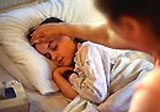According to Dr. Nguyen Van Loc, Deputy Director of the Central Pediatric Hospital, spring illnesses in children (when the weather is cold, humidity is high, and drizzles occur) are primarily viral infections.
These weather-related illnesses are generally not dangerous, but the handling attitude of parents is crucial for the health and recovery time of their children.
Avoid Cold Compresses
 |
| If a child experiences lethargy, labored breathing, rapid breaths, or abdominal retraction, they should be taken to the hospital immediately for timely treatment (Image: webtretho) |
During the cold season, respiratory illnesses are very common, but attention should be paid to fevers caused by adenoviruses due to the rapid transmission of the disease. When adenoviruses invade, children may experience high fevers, cough, sore throat, swollen lymph nodes in the jaw, red eyes, and runny noses.
The danger lies in the fact that cold compresses are still a common method for reducing fever. When a child has a fever, the body’s peripheral blood vessels dilate to release heat, so applying cold compresses constricts these vessels, causing the body temperature to rise even higher.
The best approach is to use warm compresses for children (water at a temperature of 32-35°C) on the armpits, neck, and groin to reduce temperature, as these areas have many large blood vessels. Additionally, 70% alcohol can be used on cotton to wipe the armpits and neck of the child for cooling and fever reduction. The use of warm compresses and alcohol rubbing should be done at moderate intervals.
When children are ill, their immune systems are weakened, and if their oral hygiene is not properly maintained, viruses can invade more strongly. Cleaning the mouth with a soft cloth dipped in boiled water to remove debris from the child’s mouth should be done before feeding them. It is absolutely important not to clean the child’s mouth immediately after eating, as their stomach and esophagus are straight, making them prone to vomiting.
Unlike adults, who have an average breathing rate of 15 breaths per minute, children’s breathing rates vary by age. Newborns breathe 50-60 times per minute, children aged 1-2 breathe 40 times per minute, and older children breathe about 20 times per minute. Place your hand on the child’s belly and count the rise and fall; if the child’s breathing is faster than normal for their age, it is a sign of illness. Coupled with symptoms like lethargy, labored breathing, abdominal retraction, and grunting, immediate medical attention is required.
High Risk of Chickenpox
Spring is also the season when chickenpox appears frequently due to the virus thriving in humid weather. Children who have not been vaccinated against chickenpox or who lack immunity are at high risk of contracting the disease. While chickenpox itself is benign, excessive scratching due to itching can lead to the spreading and bursting of small blisters, resulting in pockmarks all over the body, especially on the face, which can be distressing. More dangerously, from benign chickenpox, the virus can enter the bloodstream and cause meningitis, while some other strains can lead to shingles, resulting in painful rashes along the ribs.
Therefore, to prevent complications, it is essential to avoid bursting the blisters as soon as the first spots appear. If a few blisters do burst, hydrogen peroxide can be used to clean the wounds. Bathing the child with bitter leaves and ensuring they stay hydrated to prevent dehydration from excessive blistering is important. If the rash spreads widely, immediate medical attention is necessary.
Dr. Nguyen Van Loc also warns that this spring, the Pediatric Hospital has seen a significant number of cases of measles among first and second graders. The reason is that parents have… forgotten to take their children for booster vaccinations. Measles vaccinations consist of two doses: when the child is 9 months old and again at 5 years old.
NGOC HA


















































